Using rrd4j for OpenHab2 persistence
- Tutorial
OpenHab is a popular server of “smart home” (or IoT, as it’s fashionable to say now) and has already been reviewed on Habré. However, there is not as much documentation on specific aspects of server configuration as we would like. And in Russian, consider it not.
An important feature of OpenHab is its modularity. The server itself provides basic functions (even without any UI). All other functionality is provided by plugins. One of the types of plugins is persistence - providing the ability to store a history of values for items (device parameters). This is necessary to display historical data (graphics) and restore the state of items during server restart.
Existing plugins allow you to use all popular databases for storage. I’ll tell you about setting up a very interesting backend - rrd4j. This is a high-performance storage for data, which is a series of values that are time-bound. The author was inspired by the RRDTools suite, but rewrote its functionality in Java (OpenHab is also written in Java), optimized and expanded the functionality. Rrd4j storage files are not compatible with RRDTools files.
Here you need to tell what this repository is. These are one or more circular buffers that store a parameter value with a time reference. At the same time, it is possible to aggregate several changes into one buffer value (for example, take data every minute, and store one average value for 5 minutes).
So, we have an OpenHab2 installation without persistence. For tests, I will use this board:
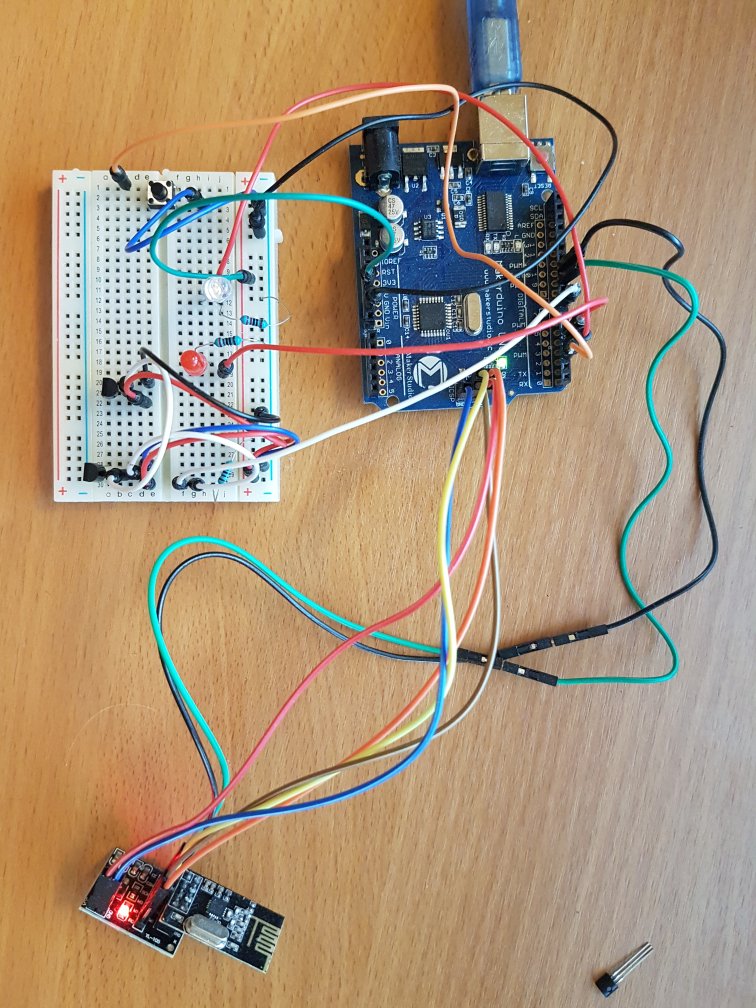
There are two Dallas 18B20 thermometers and a button on the board.
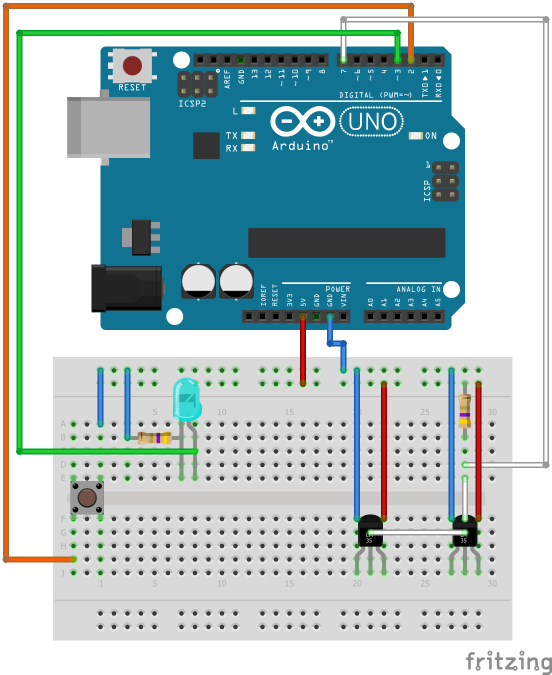
She uses MySensors to communicate with the server. By the way, the plugin for the MySensors protocol, for some reason, is not in the repository, so you need to put it by hand, download it from the forum topic and put it in the / usr / share / openhab2 / addons / folder.
A standard gateway with the same radio module is connected via USB to the server.
Yes, I prefer to use ClassicUI (and UI in OpenHab is also plugins). I would like to add a graph for two temperature sensors (see them on one graph).
First you need to install the plugin for rrd4j. Fortunately, it is in the repository.
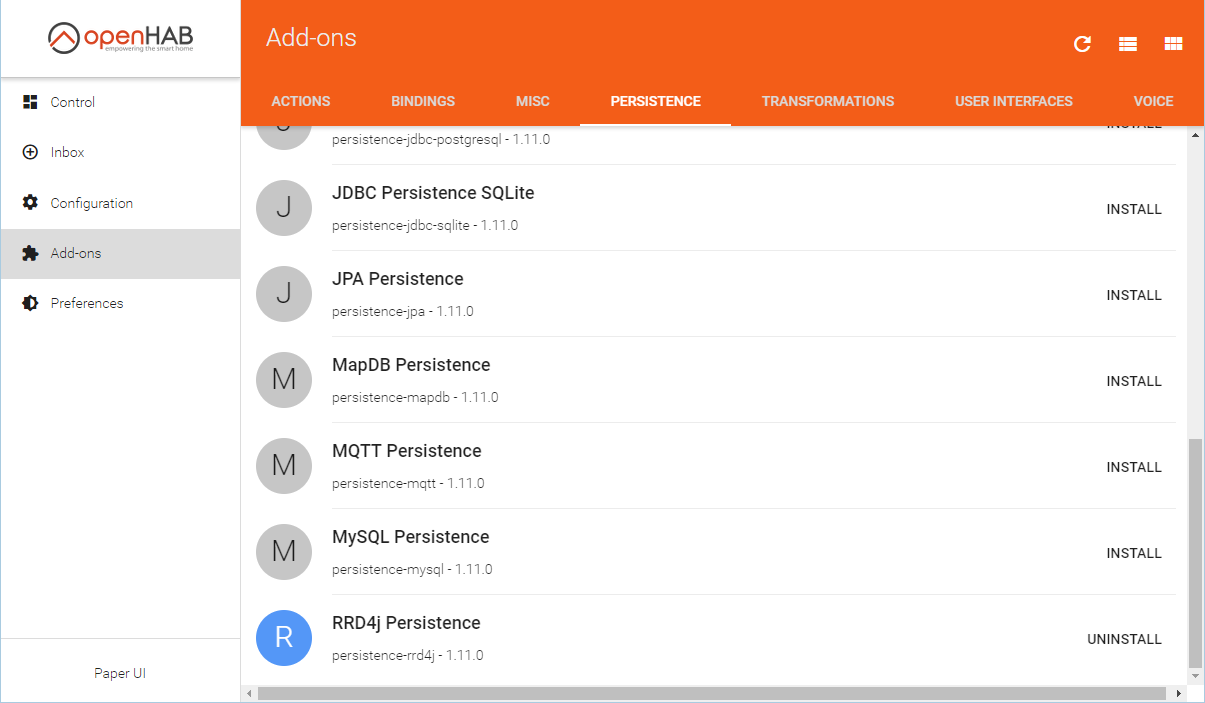
Configuring the save is done in the file /etc/openhab2/persistence/rrd4j.persist. As you can understand from the path and name, it is possible to save different data in different backends since for each of them there will be a file with a schedule and a list of items.
The file consists of two groups of settings - a strategy where the interval of saving in Quartz syntax is set and elements where strategies are set for items or groups.
In my example below, gTemperature is a group that includes both items for temperature sensors (groups need to put an asterisk after the name, otherwise the value of the group, not its members, will be saved).
We save the file, it will be re-read automatically. As you can see, we save the sensor values every minute. Now this is the best option; and why so - I will tell below.
Where is the data stored? In the folder / var / lib / openhab2 / persistence / rrd4j /. A file will be created there for each item, and the file size will be immediately such that it stores all the data, including the archive. This is declared as an important feature of RRD storage - the file does not grow uncontrollably.
Well, since everything is fine, add the graphics to ourselves in the sitemap:
Here's what it looks like on the screen:
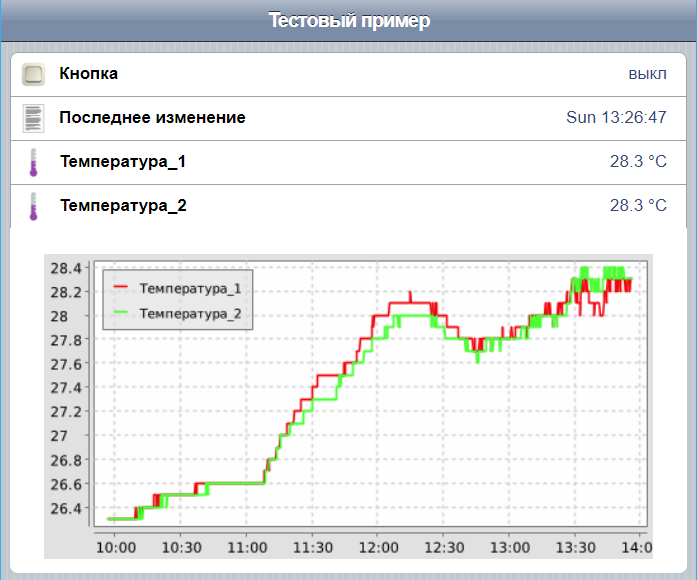
By the way, there is also a
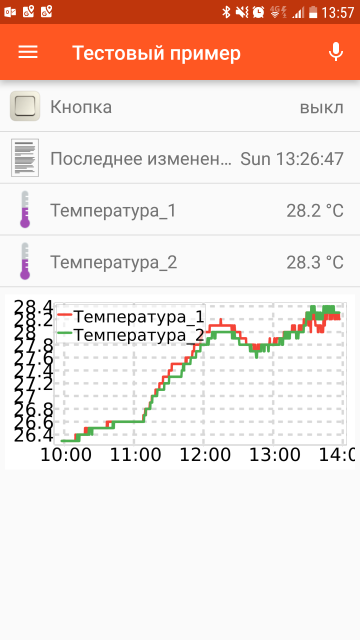
graph in the mobile application: Another interesting feature of rrd4j (and the original RRDTools) is the built-in graphics rendering engine. In OpenHab, such a graph can be inserted in another UI - HabPanel. It looks old school:
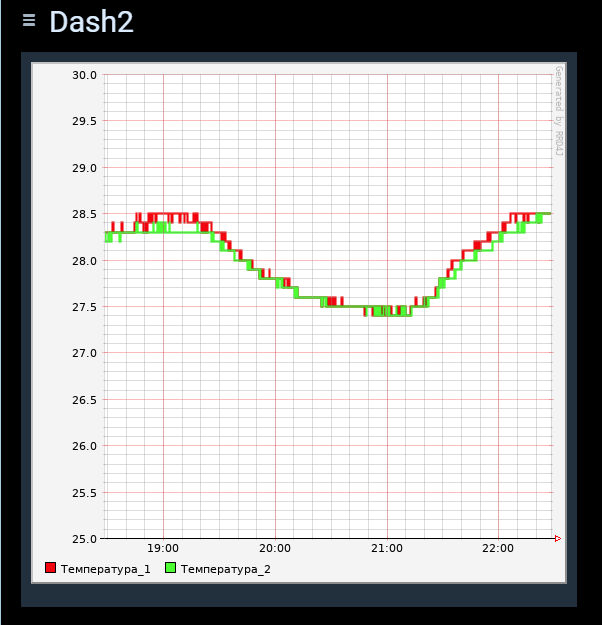
The engine is available directly from the link. It should look something like this:
w and h are the size of the graph in pixels. The groups parameter sets the names of groups to display. For individual items you need to use the items parameter. If you need to show several groups / parameters, you need to specify them separated by commas.
Okay, how does this all work? How often is the value saved? How much is stored? Anyway, rrd4j has a ton of settings, but we didn’t do anything!
To see the current storage, we will use the graphical utility that comes with the OpenHab plugin. There are no X's on my test server, so I copied the data files and the .jar plugin to the main Windows machine.
To run, of course, you need Java. It has a cool feature to run any appropriate .jar class by name. We need org.rrd4j.inspector.RrdInspector and run it like this:
And here is what we will see for our archive:
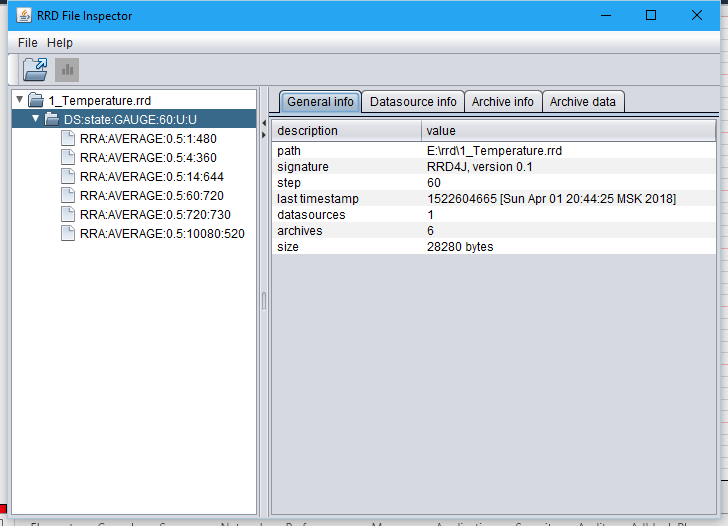
Here lies the reason that it makes no sense to save the value more often than once a minute! Data is written to the store every 60 seconds, and if you try to save more often, the average of all values will be recorded.
It's time to consider configuring rrd4j, because I would like to read the sensors more often. Yes, and I also want to record the state of the button, and not the average (what is the use of the button in it?), But the maximum value for the period, so that I know if the button was pressed in the specified period.
As you already understood, the default configuration does not suit us. So it would be nice to change it. Storage settings are in /etc/openhab2/services/rrd4j.cfg. Now the file is empty, but there is a syntax hint at the top.
So, above I already wrote general words in format. Now it's time to do the configuration. As you can see from the example, the settings go in two lines: .def and .archives. The .items parameter lists the items through which the configuration will be applied. Those parameters for which there is no configuration will be saved with the default settings (we saw them above in the Java-looker).
Let's make settings for thermometers:
As you can see, the syntax is slightly different from the classic RRDTools. In .def we set the value type to GAUGE - this is the storage of absolute values. Further heartbeat, minimum, and maximum possible values. And step.
Step is the normal interval between counts in seconds. I chose 15, as I wanted.
Hearbeat is added to step and this is the maximum time interval to save the value. If during this time (step + heartbeat = 30 sec in my case) a value is not recorded, then rrd4j will save NaN into the count.
In .archives I set the storage settings. Everything that is written to the file is configured here. As you can see, there can be several archives. The syntax of one archive is given in the description in the file.
As an aggregate function, I use AVERAGE because I have a temperature and when combining the samples you need to keep the average. Next is the xff parameter, which is poorly described on the Internet. I had to get into the source. It turned out to be a coefficient (in fact, a percentage), which determines how much NaN, when grouping, the resulting NaN is recorded.
For example, for the second archive, where 4 values are combined, with a coefficient of 0.5, the resulting NaN will be recorded if two or more source values are NaN.
The following parameters specify how many source values are written to one archive and how many archive values need to be stored (overwritten cyclically).
In my setup, I created three archives with the following parameters:
• We store each value, a total of 960 pieces (960 * 15 sec = 4 hours).
• We store the average of four values, a total of 1440 pieces (1440 * 15 sec = 24 hours).
• We store the average of 20 values, a total of 2016 pieces (2016 * 15 sec = 7 days).
We fix skills. Settings for the button:
Here I save the values every 60 seconds and store the maximum.
Yes. If you set persistence in the persistence setting more often than step in the rrd4j config, the store will group the values with an aggregate function from the first archive.
Now let's get back to setting up OpenHab (I quote only the Items part):
I set the thermometers to save every 15 seconds and set the settings for the button. We will save it every minute and when changing, which, together with the aggregate function MAX, will allow you to write to archive 1, if the button was pressed at least once during a minute.
I’m completing the sitemap and here’s what I see:
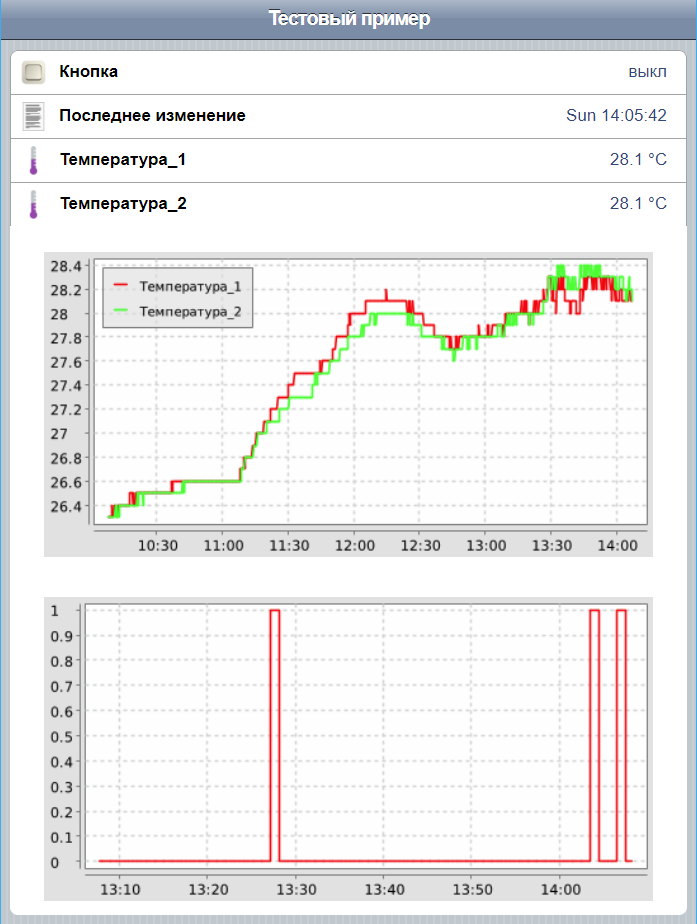
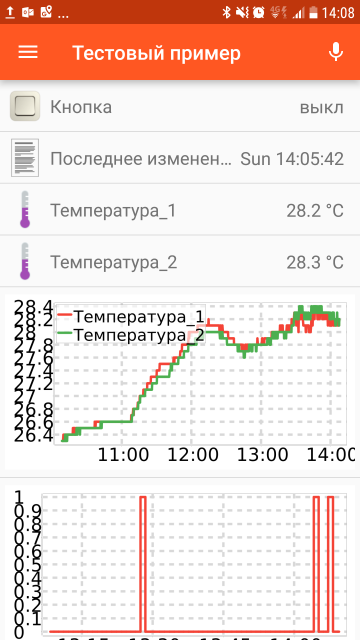
OpenHab is a good solution for “smart home” and automation of housing and communal services. Use and expand the Russian community!
An important feature of OpenHab is its modularity. The server itself provides basic functions (even without any UI). All other functionality is provided by plugins. One of the types of plugins is persistence - providing the ability to store a history of values for items (device parameters). This is necessary to display historical data (graphics) and restore the state of items during server restart.
Existing plugins allow you to use all popular databases for storage. I’ll tell you about setting up a very interesting backend - rrd4j. This is a high-performance storage for data, which is a series of values that are time-bound. The author was inspired by the RRDTools suite, but rewrote its functionality in Java (OpenHab is also written in Java), optimized and expanded the functionality. Rrd4j storage files are not compatible with RRDTools files.
Here you need to tell what this repository is. These are one or more circular buffers that store a parameter value with a time reference. At the same time, it is possible to aggregate several changes into one buffer value (for example, take data every minute, and store one average value for 5 minutes).
So, we have an OpenHab2 installation without persistence. For tests, I will use this board:

There are two Dallas 18B20 thermometers and a button on the board.

She uses MySensors to communicate with the server. By the way, the plugin for the MySensors protocol, for some reason, is not in the repository, so you need to put it by hand, download it from the forum topic and put it in the / usr / share / openhab2 / addons / folder.
A standard gateway with the same radio module is connected via USB to the server.
Firmware for the board
// Enable debug prints to serial monitor
#define MY_DEBUG
// Enable and select radio type attached
#define MY_RADIO_NRF24
// Static node id
#define MY_NODE_ID 1
#include
#include
#define SKETCH_NAME "Test board"
#define SKETCH_MAJOR_VER "1"
#define SKETCH_MINOR_VER "0"
// Item IDs
#define CHILD_ID_BTN 3
#define CHILD_ID_TEMP 10
// Pin definitions
#define PIN_BTN 2
#define PIN_BTN_LED 3
#define PIN_ONE_WIRE 7
// Messages
MyMessage msgBtn(CHILD_ID_BTN, V_STATUS);
MyMessage msgTemp(CHILD_ID_TEMP, V_TEMP);
//OneWire temperature
OneWire oneWire(PIN_ONE_WIRE);
DallasTemperature temp(&oneWire);
#define MAX_TEMP_SENSORS 10
int cntSensors = 0; // Don't support hotplug
float arrSensors[MAX_TEMP_SENSORS];
DeviceAddress arrAddress[MAX_TEMP_SENSORS];
void before()
{
temp.begin();
}
void presentation()
{
// Send the sketch version information to the gateway and Controller
sendSketchInfo(SKETCH_NAME, SKETCH_MAJOR_VER "." SKETCH_MINOR_VER);
// Present locally attached sensors
present(CHILD_ID_BTN, S_BINARY);
cntSensors = temp.getDeviceCount();
if (cntSensors > MAX_TEMP_SENSORS)
cntSensors = MAX_TEMP_SENSORS;
Serial.print("Temperature sensors found:");
Serial.print(cntSensors);
Serial.println(".");
for (int i = 0; i < cntSensors; i++)
{
present(CHILD_ID_TEMP + i, S_TEMP);
arrSensors[i] = 0;
temp.getAddress(arrAddress[i], i);
}
}
void setup()
{
// Setup locally attached sensors
pinMode(PIN_BTN, INPUT_PULLUP);
pinMode(PIN_BTN_LED, OUTPUT);
temp.setWaitForConversion(false);
temp.setResolution(12); // 0,0625 grad celsius
}
void loop()
{
// Send locally attached sensor data here
static unsigned long owNextConversTm = 0;
if (0 == owNextConversTm)
{
temp.requestTemperatures();
int16_t owConversTm = temp.millisToWaitForConversion(temp.getResolution());
owNextConversTm = millis() + owConversTm + 50; // Wait a little more
}
else if (owNextConversTm < millis() && temp.isConversionComplete())
{
for (int i = 0; i < cntSensors; i++)
{
if (temp.validFamily(arrAddress[i]))
{
int t1 = temp.getTempC(arrAddress[i]) * 10;
float t = t1 / 10 + (t1 % 10) * 0.1;
if (t != arrSensors[i])
{
send(msgTemp.setSensor(CHILD_ID_TEMP + i).set(t, 1));
arrSensors[i] = t;
Serial.print("Sensor #");
Serial.print(i);
Serial.print(", temperature: ");
Serial.print(t);
Serial.println(" C.");
}
}
}
owNextConversTm = 0;
}
else if ((owNextConversTm + 30000) < millis())
{ // It was couter reset
owNextConversTm = 0;
}
static int currVal = HIGH;
int val = digitalRead(PIN_BTN);
if (val != currVal)
{
digitalWrite(PIN_BTN_LED, val == HIGH ? LOW : HIGH);
send(msgBtn.set(val == LOW));
currVal = val;
Serial.print("Btn state changed to ");
Serial.println(val == HIGH ? "off." : "on.");
}
}
Yes, I prefer to use ClassicUI (and UI in OpenHab is also plugins). I would like to add a graph for two temperature sensors (see them on one graph).
First you need to install the plugin for rrd4j. Fortunately, it is in the repository.

Configuring the save is done in the file /etc/openhab2/persistence/rrd4j.persist. As you can understand from the path and name, it is possible to save different data in different backends since for each of them there will be a file with a schedule and a list of items.
The file consists of two groups of settings - a strategy where the interval of saving in Quartz syntax is set and elements where strategies are set for items or groups.
Strategies
{
// Strategy name
// | Seconds
// | | Minutes
// | | | Hours
// | | | | Day of month
// | | | | | Month
// | | | | | | Day of week
// | | | | | | | Year
every5sec : "0/5 * * * * ?"
every15sec : "0/15 * * * * ?"
everyMinute : "0 * * * * ?"
every30min : "0 30 * * * ?"
everyHour : "0 0 * * * ?"
everyDay : "0 0 0 * * ?"
default = everyChange
}
Items
{
gTemperature* : strategy = everyMinute, restoreOnStartup
}
In my example below, gTemperature is a group that includes both items for temperature sensors (groups need to put an asterisk after the name, otherwise the value of the group, not its members, will be saved).
We save the file, it will be re-read automatically. As you can see, we save the sensor values every minute. Now this is the best option; and why so - I will tell below.
Where is the data stored? In the folder / var / lib / openhab2 / persistence / rrd4j /. A file will be created there for each item, and the file size will be immediately such that it stores all the data, including the archive. This is declared as an important feature of RRD storage - the file does not grow uncontrollably.
root@chubarovo:/etc/openhab2# ll -h1 /var/lib/openhab2/persistence/rrd4j/
total 78K
drwxr-xr-x 2 openhab openhab 4.0K Apr 7 21:53 ./
drwxr-xr-x 5 openhab openhab 4.0K Feb 18 18:59 ../
-rwxr-xr-x 1 openhab openhab 32 Dec 18 15:44 Readme.txt*
-rw-r--r-- 1 openhab openhab 35K Apr 7 21:54 Test_temp1_soc.rrd
-rw-r--r-- 1 openhab openhab 35K Apr 7 21:54 Test_temp2_soc.rrd
Well, since everything is fine, add the graphics to ourselves in the sitemap:
sitemap test label="Тестовый пример"
{
Text item=Test_button_soc label="Кнопка [MAP(ru.map):%s]"
Text item=Test_temp1_soc
Text item=Test_temp2_soc
Chart item=gTemperature refresh=60000 period=4h
}
Here's what it looks like on the screen:

By the way, there is also a

graph in the mobile application: Another interesting feature of rrd4j (and the original RRDTools) is the built-in graphics rendering engine. In OpenHab, such a graph can be inserted in another UI - HabPanel. It looks old school:

The engine is available directly from the link. It should look something like this:
http://192.168.144.243:8080/rrdchart.png?groups=gTemperature&theme=black&period=h&h=464&w=447w and h are the size of the graph in pixels. The groups parameter sets the names of groups to display. For individual items you need to use the items parameter. If you need to show several groups / parameters, you need to specify them separated by commas.
Okay, how does this all work? How often is the value saved? How much is stored? Anyway, rrd4j has a ton of settings, but we didn’t do anything!
To see the current storage, we will use the graphical utility that comes with the OpenHab plugin. There are no X's on my test server, so I copied the data files and the .jar plugin to the main Windows machine.
To run, of course, you need Java. It has a cool feature to run any appropriate .jar class by name. We need org.rrd4j.inspector.RrdInspector and run it like this:
java -cp rrd4j-2.1.1.jar org.rrd4j.inspector.RrdInspectorAnd here is what we will see for our archive:

Here lies the reason that it makes no sense to save the value more often than once a minute! Data is written to the store every 60 seconds, and if you try to save more often, the average of all values will be recorded.
It's time to consider configuring rrd4j, because I would like to read the sensors more often. Yes, and I also want to record the state of the button, and not the average (what is the use of the button in it?), But the maximum value for the period, so that I know if the button was pressed in the specified period.
As you already understood, the default configuration does not suit us. So it would be nice to change it. Storage settings are in /etc/openhab2/services/rrd4j.cfg. Now the file is empty, but there is a syntax hint at the top.
So, above I already wrote general words in format. Now it's time to do the configuration. As you can see from the example, the settings go in two lines: .def and .archives. The .items parameter lists the items through which the configuration will be applied. Those parameters for which there is no configuration will be saved with the default settings (we saw them above in the Java-looker).
Let's make settings for thermometers:
# each 15 sec
temps.def=GAUGE,15,0,100,15
# 4h/15s : 1m/24h : 5m/7d
temps.archives=AVERAGE,0.5,1,960:AVERAGE,0.5,4,1440:AVERAGE,0.5,20,2016
temps.items=Test_temp1_soc,Test_temp2_socAs you can see, the syntax is slightly different from the classic RRDTools. In .def we set the value type to GAUGE - this is the storage of absolute values. Further heartbeat, minimum, and maximum possible values. And step.
Step is the normal interval between counts in seconds. I chose 15, as I wanted.
Hearbeat is added to step and this is the maximum time interval to save the value. If during this time (step + heartbeat = 30 sec in my case) a value is not recorded, then rrd4j will save NaN into the count.
In .archives I set the storage settings. Everything that is written to the file is configured here. As you can see, there can be several archives. The syntax of one archive is given in the description in the file.
As an aggregate function, I use AVERAGE because I have a temperature and when combining the samples you need to keep the average. Next is the xff parameter, which is poorly described on the Internet. I had to get into the source. It turned out to be a coefficient (in fact, a percentage), which determines how much NaN, when grouping, the resulting NaN is recorded.
For example, for the second archive, where 4 values are combined, with a coefficient of 0.5, the resulting NaN will be recorded if two or more source values are NaN.
The following parameters specify how many source values are written to one archive and how many archive values need to be stored (overwritten cyclically).
In my setup, I created three archives with the following parameters:
• We store each value, a total of 960 pieces (960 * 15 sec = 4 hours).
• We store the average of four values, a total of 1440 pieces (1440 * 15 sec = 24 hours).
• We store the average of 20 values, a total of 2016 pieces (2016 * 15 sec = 7 days).
We fix skills. Settings for the button:
# each 60 sec
temps.def=DERIVE,60,0,100,60
# 6h/60s : 5m/24h : 5m/7d
temps.archives=MAX,0.5,1,360:MAX,0.5,5,288:MAX,0.5,30,336
temps.items=Test_button_socHere I save the values every 60 seconds and store the maximum.
Yes. If you set persistence in the persistence setting more often than step in the rrd4j config, the store will group the values with an aggregate function from the first archive.
Now let's get back to setting up OpenHab (I quote only the Items part):
Items
{
gTemperature* : strategy = every15sec, restoreOnStartup
Test_button_soc : strategy = everyMinute, everyChange
}I set the thermometers to save every 15 seconds and set the settings for the button. We will save it every minute and when changing, which, together with the aggregate function MAX, will allow you to write to archive 1, if the button was pressed at least once during a minute.
I’m completing the sitemap and here’s what I see:


OpenHab is a good solution for “smart home” and automation of housing and communal services. Use and expand the Russian community!
